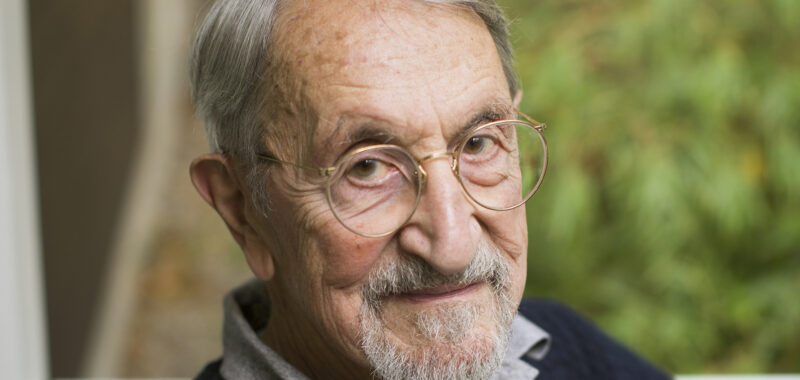A giant in the field of theoretical chemistry, Martin Karplus was renowned for transforming our understanding of molecular systems, his groundbreaking work in computational modeling, and his contributions to molecular dynamics simulations. He will also be warmly remembered for his mentorship and his devotion to advancing theoretical chemistry research and education across the world.
“Karplus made theoretical chemistry a legitimate field of chemistry,” said Eugene Shakhnovich, a former postdoc in Karplus’ lab who is now the Roy G. Gordon Professor of Chemistry in the Department of Chemistry and Chemical Biology. “His work showed that by doing computational work, without experiments, one can gain great insights and help experimentalists not only understand but also predict outcomes.”
Karplus, the Theodore William Richards Professor of Chemistry, Emeritus, was a member of the National Academy of Sciences, the American Academy of Arts & Sciences, and a foreign member of the Netherlands Academy of Arts & Sciences and the Royal Society of London. He received many honors and awards over his long career, including the Nobel Prize in chemistry. Karplus passed away Dec. 28 in Cambridge at the age of 94.
From the archives
-

‘I had the conviction that my ideas were correct’
Interview with Nobel Prize winner Martin Karplus as part of the Experience series.
Born into a Jewish family on March 15, 1930, in Vienna, Karplus’ childhood was interrupted by the rise of the Nazi regime, which forced his family to flee following the Anschluss in 1938. Their refugee journey took them through Switzerland and France before they reached the U.S.
Settling in Greater Boston, Karplus pursued his undergraduate degree at Harvard, graduating in 1951. He earned his Ph.D. at the California Institute of Technology in 1953 under the supervision of Linus Pauling, one of the founders of the fields of quantum chemistry and molecular biology. Pauling, who received the Nobel Prize in chemistry in 1954, recognized Karplus’ talent and potential, describing him as “my most brilliant student.”
Upon earning his doctorate, Karplus completed a postdoctoral fellowship at Oxford before joining the faculty at the University of Illinois Urbana-Champaign, where his research on molecular structure led to the formulation of the widely taught “Karplus equation,” a fundamental principle relating molecular structure to nuclear magnetic resonance data. He moved to Columbia University in 1960, working on chemical reaction dynamics with early digital computers to break new ground.

Karplus addresses the media after winning the Nobel Prize in chemistry in 2013.
Harvard file photo
In 1966, Karplus returned to Harvard as a tenured professor, a position he held for more than five decades. Here, he applied the fundamental laws of physics and chemistry to proteins and macromolecules, envisioning methods to understand life processes.
“Martin was a great unifier of physics, chemistry, and biology, showcasing his broad impact across multiple scientific disciplines,” said James Anderson, Philip S. Weld Professor of Atmospheric Chemistry and a longtime colleague. “History will clarify the fact that he was the backbone of quantum mechanics during its flowering years, from an analysis of the hydrogen atom all the way to the formation of molecules, molecular structures, and the way in which molecules change their structure during a chemical reaction.”
“Martin was a great unifier of physics, chemistry, and biology.”
James Anderson, Philip S. Weld Professor of Atmospheric Chemistry
Karplus made seminal contributions in the field of molecular dynamics, where he developed simulations that allowed researchers to visualize and predict the motion of molecules in complex systems. In 1983, Karplus and his co-authors developed the widely used software program Chemistry at HARvard Macromolecular Mechanics to simulate biological interactions across a wide range of scenarios. Karplus’ innovations transformed the study of chemical reactions and protein folding.
Having long dreamed of working in France, Karplus joined the faculty at the University in Strasbourg, splitting his time between there and Cambridge. In 2013, Karplus, alongside Michael Levitt and Arieh Warshel, was awarded the Nobel Prize for “the development of multiscale models for complex chemical systems.”
In addition to his vital research, Karplus was a dedicated educator who sought to teach chemistry to students at different levels across higher education. His textbook “Atoms and Molecules” has been a mainstay in undergraduate physical chemistry courses for years. He also fostered a robust and international network of scholars who studied in his lab, providing both professional and personal support. Shakhnovich, who was born and trained in the Soviet Union, recalled Karplus’ warm reception when he came to the U.S. in 1990.
“Martin was first person I saw in the United States, because he was kind enough to come to the airport to pick up me and my family,” Shakhnovich said. “His support at the very beginning of my career in this country was absolutely crucial and instrumental.”
Said Anderson of Karplus’ global influence: “His postdocs, graduate, and undergraduate students are found on the faculty of virtually every major university in the United States and Europe. That’s a legacy that speaks for itself, reflecting his profound impact in academia worldwide.”
Dan Kahne, Higgins Professor of Chemistry and Chemical Biology and chair of the Department of Chemistry and Chemical Biology, recalled Karplus’ pioneering research as pivotal.
“He was way ahead of his time, anticipating the importance of the biological tools he was developing to address protein dynamics and folding long before anyone else did,” Kahne said.
Karplus is survived by his wife, Marci; son, Mischa; daughters Reba and Tammy; and granddaughter, Rachel.
Source link

